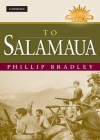To Salamaua,
Written by: Phillip Bradley,
Cambridge University Press, Melbourne, 2010,
ISBN 9780521763905, 390pp
Reviewed by: John Moremon, Centre for Defence and Security Studies, Massey University, NZ
The late Cam Bennett, whose Rough Infantry is one of a few memoirs of the Salamaua campaign, commented that he ‘found it extremely hard to write about the war in New Guinea’. It was not just that the tropical, jungle-clad, mountainous island was so different from Libya, Greece and Syria. It was also that the six-month advance from Wau to Salamaua in 1943 ‘imposed almost universal hardship on the troops ...’
The challenge Phillip Bradley faced was to produce a history of a campaign that veterans found hard to explain and which today is little known. It is nearly five decades since the last decent account in David Dexter’s The New Guinea Offensives, published in 1961. Of course, Bradley is a champion of lesser known New Guinea campaigns, with this book following On Shaggy Ridge and The Battle for Wau.
Bradley positions the campaign within the wider events of the Second World War, although he stumbles with a claim that the German Army had been ‘decisively defeated at Stalingrad and was in retreat, desperately trying to hold back the Soviet tide’. Certainly Stalingrad was a disaster, but in early 1943 the Germans planned fresh offensives; admittedly, they failed. Within a few pages, there is a worrying sign of ‘plane-spotting’, to which Bradley can be prone, as for no apparent reason he gives the serial number of a Catalina flying boat flown on patrol over the Bismarck Sea. Fortunately, these turn out to be uncharacteristic, as To Salamaua is based on solid research with judicious editing. (Bradley remains infatuated with precise timings and with numbers.)
Bradley appreciates that nowadays few readers will have served in the war and fewer still have travelled to this part of New Guinea. Not only has he walked the ground, he possesses the skill to convey a sense of that ground. Key positions such as Bobdubi Ridge or Old Vickers are described clearly—and battles upon them portrayed evocatively. There is also a sense of the participants, whether they be Australian, American, New Guinean or Japanese, and from any service. Further, there are strong character sketches of commanders and some ‘ordinary’ men who accomplished extraordinary deeds, such as Corporal Leslie ‘Bull’ Allen MM, stretcher-bearer.
Bradley takes the time to explain units, including a sound explanation of a brigade and battalion at that time, along with weapons and equipment. Early in the book he outlines the Japanese fleet that sailed into the Bismarck Sea in March 1943, and Allied air force units pitched against the fleet. His description of air force training and tactics devised ahead of the Battle of the Bismarck Sea is first-rate (except for seemingly forgetting to explain what is meant by ‘skip-bombing’). Likewise, for the Australian-American advance on Salamaua Bradley shows an eye for compelling stories so that his narrative equals, if not surpasses Dexter’s official account.
If there is a shortcoming, it is that while the narrative is impressive the analysis can be wanting. Bradley discusses tactical and logistical challenges without great depth. For example, he describes the slowly-constructed Bulldog Road but does not assess the project; he explains supply dropping without appreciating evolving air transport methods; and there is not a strong enough sense of the evolution of jungle warfare tactics or differences between Australian and US doctrines.
A great strength is that all maps and illustrations complement the text, however, the quality is variable. Keith Mitchell’s maps are outstanding (as always) and those by Rohan Bola are impressive. Other maps are from the official history; those originally in colour do not reproduce well in black-and-white, as some text appears faint, while those that originally were small sketches have been enlarged so that in some cases there is pixilation. Otherwise this is an exceptionally well presented book, further boosted with photographs by some of Australia’s best wartime cameramen.
With To Salamaua, Bradley has met the challenge of narrating a campaign many veterans could not write about. There remains scope to dig deeper so that we might better understand how the Australian Army conducted its 1943–44 campaigns. Nevertheless, this book is recommended; it will be especially appreciated by the few remaining veterans and their descendents. Soldiers too will learn of challenges and may better appreciate this episode in the Army’s history.

